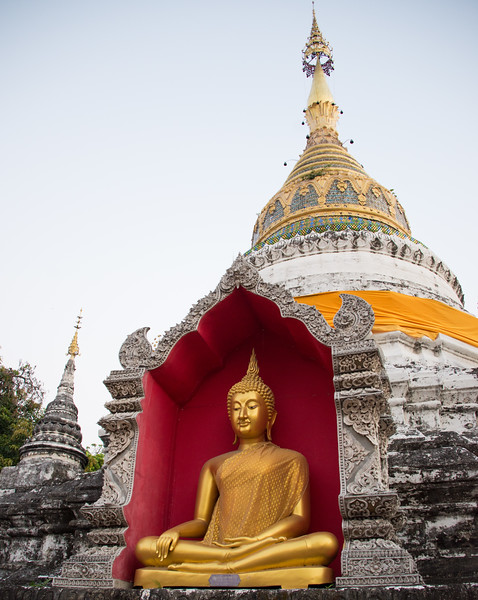
Wat Buppharam in Chiang Mai, Thailand, home of khao soi.
Along with talking to locals, visiting historical sites and browsing museums and shops, eating—and cooking—the regional cuisine always helps me to understand a new place. When I don’t have friends to show me the culinary ropes, I turn to hands-on cooking classes. That’s how I ended up at the Green Mango Thai Cookery School in Chiang Mai,Thailand. Situated on a lush, bamboo- and coconut-tree lined property about 20 minutes from the center of Chiang Mai, Green Mango provided a lovely setting, well-stocked cook stations and delicious, classic recipes. Better still, it gave me a chance to learn from a native chef, shop for fresh ingredients and cook like Northern Thais do.
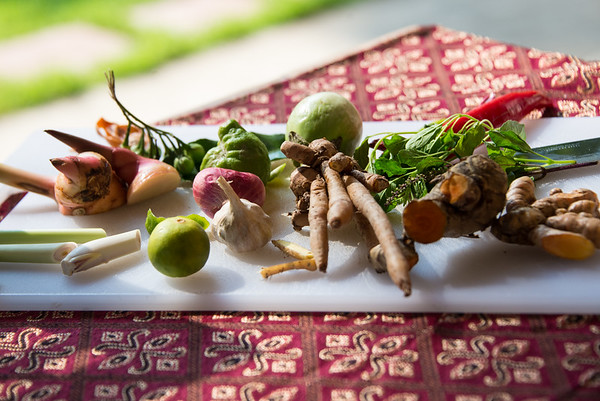
Flavors of Thai cooking (clockwise from top): Thai eggplant, chilies, turmeric, finger root, shallot & garlic, lime, lemongrass, galangal, mace, pea eggplant, kefir lime and lime leaves
Among the traditional dishes made at Green Mango was khao soi (also spelled “kôw soy”). A specialty of Chiang Mai, this spicy curry features red curry paste, wheat- and egg-noodles and beef or chicken. Since I was the lone pescetarian in attendance, I was allowed to make an untraditional version of this culinary icon, shrimp khao soi.
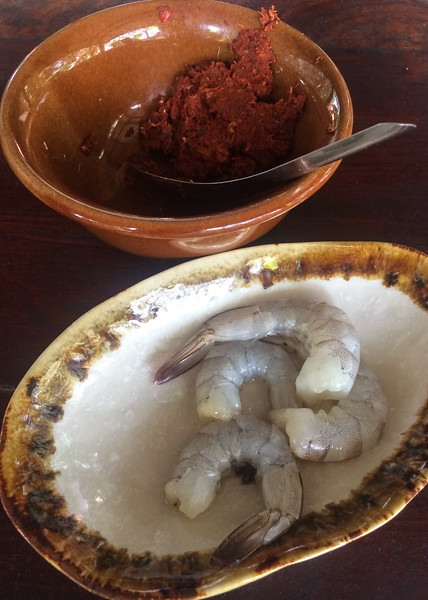
Two star ingredients in shrimp khao soi, fresh red curry paste and shrimp
To begin, I pummeled together such Thai favorites as lemongrass, galangal and finger root with a mortar and pestle. Once a smooth, colorful paste had formed, I brought a pan of coconut milk to a boil. A staple of Thai cuisine, coconut milk serves as the base for most curries. It also acted as a garnish for my shrimp khao soi.
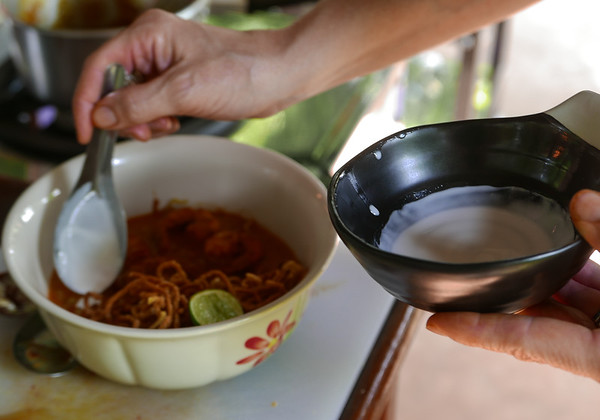
Garnishing my shrimp khao soi with crispy noodles, a slice of lime and coconut milk.
After boiling the milk, I added the curry paste and stirred the ingredients together. Within seconds a rich, spicy scent wafted up from my saucepan. Bold in color and aroma but even more assertive in flavor, this dish set the standard for all other curries. It, like my time at the Green Mango Thai Cookery School, remains a high point of visiting Northern Thailand.
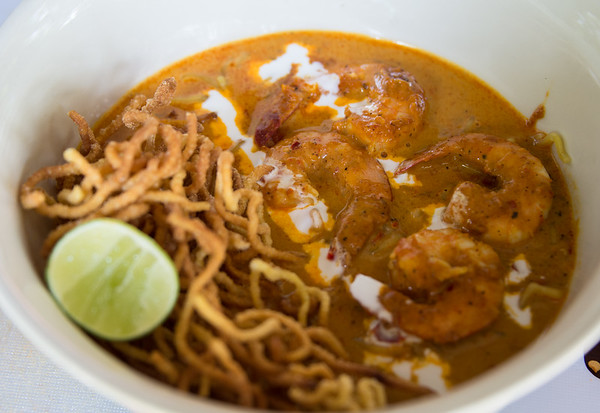
The finished dish, shrimp khao soi
SHRIMP KHAO SOI
Recipe adapted from the Green Mango Thai Cookery School
Serves 1
for the curry paste:
1 tablespoon sliced lemongrass
1 slice of fresh galangal and turmeric
Small piece of finger root
Zest from 1 kefir lime
Mace or grated nutmeg
Pinch of coriander, cumin seeds, garlic, shallot and shrimp paste
3 large dried chili peppers, soaked in water to soften
1 long pepper
1 cardamom pod
Half dried bay leaf
Small piece of cinnamon stick
1/2 star anise
Pinch of fennel
for the khao soi:
1 1/2 cups coconut milk, divided
Curry paste
4 shrimp
1/2 cup water
1 teaspoon curry powder
1 teaspoon masala powder
Stir fried egg noodles, for garnish
Cilantro (coriander leaf), for garnish
Sliced shallot, for garnish
Scant amount of coconut milk
Small lime, quartered, for garnish
for the stir fried egg noodles:
1/2 to 1 tablespoon canola oil
1/3 to 1/2 cup fresh egg noodles
Using a mortar and pestle, mash together the lemongrass, galangal, turmeric and finger root until a soft paste forms. Add the kefir lime zest, strip of mace or grated nutmeg, coriander, cumin seeds, garlic, shallot and shrimp paste and continue pounding with the pestle until the ingredients are well combined. Add the remaining ingredients and crush until a firm, evenly mixed paste forms. Note that you can also make this curry paste by pulsing the ingredients together in a food processor.
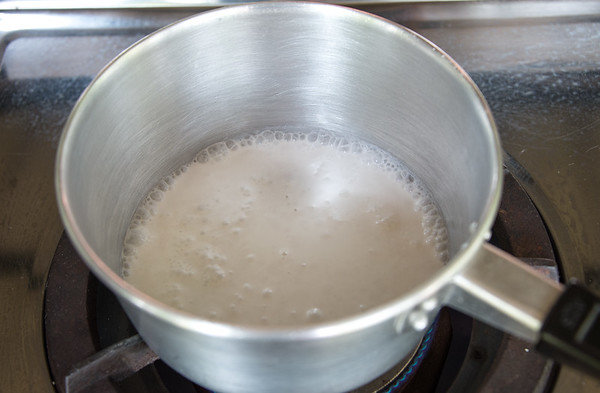
Simmering the coconut milk
In a medium saucepan bring half the coconut milk to a boil and simmer for 3 minutes. Add the curry paste and stir until well combined. Add the shrimp and allow it to cook for 2 to 3 minutes, until the flesh has turned coral in color and the shrimp begins to curl. Remove the shrimp from the saucepan and set aside.
Add the remaining coconut milk, water, curry powder and masala and stir to combine. Allow the ingredients to simmer for 5 to 10 minutes, until the flavors have melded together and the curry has cooked down.
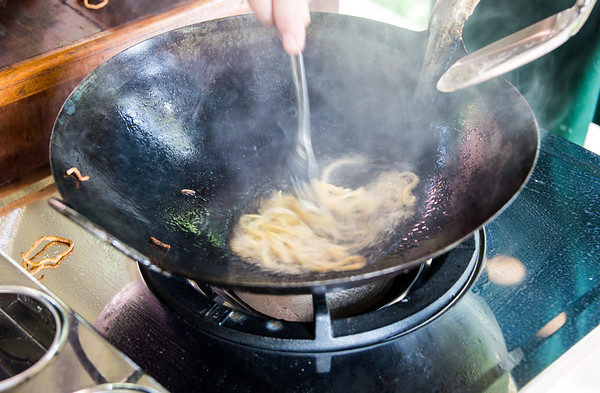
Stir frying the egg noodles
While the curry is simmering, make the stir-fried egg noodles. Heat 1 tablespoon canola oil on high in a wok or sauté pan. Add the egg noodles and toss until browned, about 1 minute total. Remove the noodles from the pan and allow them to drain on a clean, dry cloth.
Add the shrimp back to the pan and toss lightly to reheat. Spoon the curry into a large bowl, sprinkle the noodles, shallots and cilantro over top and drizzle coconut milk over this. Serve shrimp khao soi alongside the quartered lime.